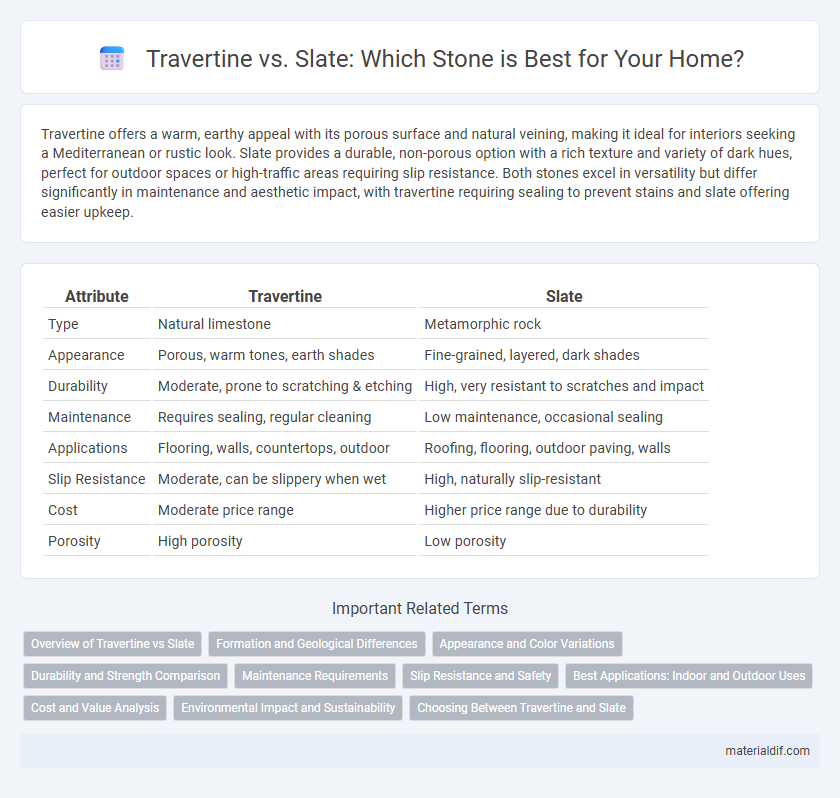Travertine offers a warm, earthy appeal with its porous surface and natural veining, making it ideal for interiors seeking a Mediterranean or rustic look. Slate provides a durable, non-porous option with a rich texture and variety of dark hues, perfect for outdoor spaces or high-traffic areas requiring slip resistance. Both stones excel in versatility but differ significantly in maintenance and aesthetic impact, with travertine requiring sealing to prevent stains and slate offering easier upkeep.
Table of Comparison
| Attribute | Travertine | Slate |
|---|---|---|
| Type | Natural limestone | Metamorphic rock |
| Appearance | Porous, warm tones, earth shades | Fine-grained, layered, dark shades |
| Durability | Moderate, prone to scratching & etching | High, very resistant to scratches and impact |
| Maintenance | Requires sealing, regular cleaning | Low maintenance, occasional sealing |
| Applications | Flooring, walls, countertops, outdoor | Roofing, flooring, outdoor paving, walls |
| Slip Resistance | Moderate, can be slippery when wet | High, naturally slip-resistant |
| Cost | Moderate price range | Higher price range due to durability |
| Porosity | High porosity | Low porosity |
Overview of Travertine vs Slate
Travertine, a sedimentary limestone formed by mineral springs, features a porous texture and warm, earthy tones ideal for rustic and Mediterranean designs. Slate, a metamorphic rock derived from shale, offers a dense, fine-grained surface with natural cleft texture, favored for its durability and slate-gray color palette. Both stones serve as popular choices in flooring and wall applications, but travertine's softer composition contrasts with slate's hardness and slip resistance.
Formation and Geological Differences
Travertine forms primarily through the precipitation of calcium carbonate from mineral-rich hot springs or limestone caves, resulting in a porous, sedimentary rock with a fibrous or concentric appearance. Slate, on the other hand, originates from the low-grade metamorphism of shale or mudstone under directed pressure, producing a fine-grained, foliated, and durable metamorphic rock. These distinct geological processes influence their textures, durability, and typical uses in construction and design.
Appearance and Color Variations
Travertine features a natural, porous texture with warm earth tones ranging from creamy beige to rusty reds, creating a rustic yet elegant look ideal for both indoor and outdoor applications. Slate offers a denser, layered appearance with a smooth or cleft surface and exhibits a broad palette of colors, including deep grays, greens, purples, and blues, often showing subtle color variation within a single slab. The contrasting textures and color ranges of travertine and slate make them distinct choices for enhancing architectural aesthetics and design schemes.
Durability and Strength Comparison
Travertine offers moderate durability with a porous surface that requires sealing to resist stains and weathering, making it suitable for indoor applications but less ideal for high-traffic outdoor areas. Slate boasts superior strength and density, providing exceptional resistance to scratches, chips, and extreme weather conditions, which makes it a preferred choice for roofing, flooring, and outdoor installations. When comparing durability, slate generally outperforms travertine in longevity and maintenance demands, especially in harsh environments.
Maintenance Requirements
Travertine requires regular sealing to prevent staining and damage from acidic substances, making its maintenance moderately demanding. Slate is highly durable and naturally resistant to moisture and scratches, resulting in lower upkeep needs and easier cleaning routines. Both stones benefit from routine sweeping and prompt spill management to maintain their appearance and longevity.
Slip Resistance and Safety
Travertine exhibits moderate slip resistance due to its porous texture, making it safer in dry environments but potentially slippery when wet. Slate offers higher slip resistance with its natural cleft surface, providing enhanced traction and superior safety for areas prone to moisture. Choosing slate over travertine significantly reduces the risk of slips and falls, especially in outdoor or wet settings.
Best Applications: Indoor and Outdoor Uses
Travertine excels in indoor applications such as flooring, bathroom walls, and kitchen backsplashes due to its porous texture and warm, natural tones. Slate offers superior durability and slip resistance, making it ideal for outdoor patios, walkways, and roofing in various climates. Both stones provide unique aesthetic appeal, but slate's weather-resistant properties make it better suited for harsh outdoor conditions compared to travertine.
Cost and Value Analysis
Travertine typically costs between $4 to $7 per square foot, offering a mid-range price point compared to slate, which ranges from $6 to $12 per square foot due to its durability and unique texture. Value analysis shows travertine provides a warm, classic aesthetic ideal for indoor applications, while slate's higher price correlates with exceptional resistance to weather and heavy foot traffic, enhancing its lifespan outdoors. Homeowners prioritizing long-term investment may favor slate for longevity, whereas those seeking cost-effective elegance might opt for travertine.
Environmental Impact and Sustainability
Travertine, a natural limestone, is formed through mineral deposits in hot springs, making it abundant but energy-intensive to quarry and process, which can result in higher carbon emissions compared to slate. Slate, a metamorphic rock formed under pressure from shale, has a longer lifespan and lower maintenance requirements, contributing to greater sustainability in construction. Both stones can be sourced responsibly, but slate's durability and lower energy extraction process generally offer a smaller environmental footprint.
Choosing Between Travertine and Slate
Travertine offers a warm, natural appearance with porous texture that suits Mediterranean and rustic designs, while slate provides a dense, durable surface ideal for high-traffic areas and modern aesthetics. Choosing between travertine and slate depends on factors like environmental exposure, maintenance preferences, and slip resistance, where travertine requires sealing and is softer compared to the harder, low-maintenance slate. Consider the stone's color variations, cost ranges, and installation complexity to match the intended use and design vision effectively.
Travertine vs Slate Infographic

 materialdif.com
materialdif.com